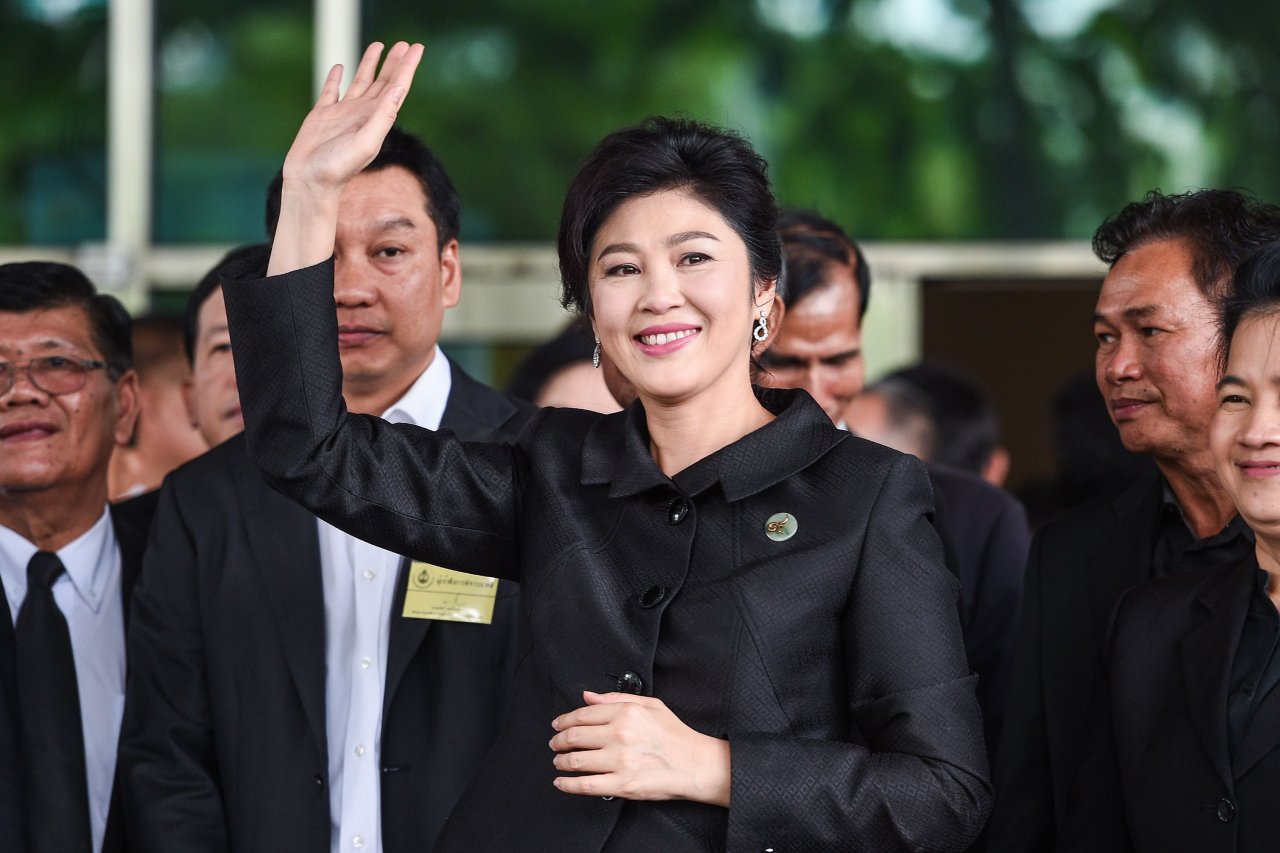Exclusive details of Yingluck investigation rulings revealed
The final rulings for the high profile court case against Yingluck Shinatwatra have finally been revealed for the general public to see.
ONLY ONE JUDGE SAID EX-PREMIER DID NOT HAVE ILL INTENT IN RICE-PLEDGING SCHEME
THE SUPREME Court’s Criminal Division for Political Office Holders on Tuesday published the full combined verdict as well as individual judgements of nine judges in the case against fugitive former prime minister Yingluck Shinawatra regarding her government’s rice-pledging scheme.
The full 95-page verdict was read on September 27 in absentia after Yingluck fled the country before the scheduled first reading of the verdict on August 25. She was subsequently found guilty of malfeasance and sentenced to five years in prison. Of the nine judges, Pison Pirun was the only one who ruled that she was not guilty.
The eight others provided similar reasons that Yingluck had been aware of extensive corruption in the rice-pledging scheme. As prime minister at the time, she had received notice from relevant agencies, such as the National Anti-Corruption Commission (NACC) and the Office of Auditor-General, warning of possible negative impacts, particularly to the national treasury, the eight judges wrote.
An aggravating factor was the motion of no confidence that the opposition party had raised to expose irregularities in the flagship scheme.
However, Yingluck had allowed the scheme to proceed even though she, as head of government, had the necessary authority and resources to end the programme before it hurt the country, the judges concluded. Each of the eight judges who ruled Yingluck guilty provided judgements individually, with the verdicts ranging from 80 to 120 pages. Pison’s verdict was relatively concise at 14 pages.
He said the Attorney-General had prosecuted Yingluck for negligence or misconduct, but according to the law the offence must be accompanied by ill intentions to cause loss to others. The act of negligence alone did not count as an offence in light of the laws cited by the Attorney-General, Pison argued.
Although the prosecutor had proven the rice-pledging scheme was plagued with corruption, there was no evidence that Yingluck had benefited, Pison wrote. Although the prosecutor and Yingluck had argued extensively about whether the rice-pledging scheme had caused losses or been beneficial to the economy, Pison wrote that those arguments were irrelevant in the context of the law.
He also rejected Yingluck’s arguments regarding judicial power as irrelevant. Pison summed up his verdict by ruling that the case against Yingluck should be dismissed.Cheep It is true that the (former) prime minister had the duty to direct the grand policy, but overseeing the implementation was equally important, especially in regard to the graft-combating and prevention policy, which had also been declared before Parliament.
The defendant [Yingluck] should not have relied solely on reports from relevant agencies. When they reported that irregularities had not been found, Yingluck was negligent and took no further action. This was despite the fact that she had legal and economic advisers.
If Yingluck had not been negligent of her duty, the huge loss incurred by corruption could have been prevented. Yingluck also had authority and sufficient time to put a halt to the delivery of the rice in the fake G2G (government-to-government) deals, but failed to do so.
This demonstrated Yingluck was negligent, and appeared to intend to help people in the fake G2G case to gain profit.
Yingluck, as the prime minister and head of the national rice policy committee, had the responsibility to oversee all the heads of the subcommittees she had appointed. But … she allowed those people to commit fraud.
Also, despite the fact that anti-corruption agencies and no-confidence motions had alerted her to the case, Yingluck failed to stop the corruption, which resulted in losses. Such an action was malfeasance. When Yingluck was aware of the corruption, and failed to stop it, this meant that she had a motivation to incur losses to the national treasury and the country.
The fact that the national rice policy committee resolved to continue pledging prices regardless of the huge deficit showed the scheme was completely political, rather than in the national interest. At the time, the programme was facing a serious liquidity crunch and needed a way out. As the committee refused to reduce the pledged prices, the government did not have the money to pay farmers.
Consequently, the rice growers were affected greatly. Although the committee later limited the amount of rice in the scheme, a huge loss had already been incurred. Yingluck may argue she had appointed other officials to be in charge of the matter.
But she could not deny or be free from the duty and responsibility. When she learned of the loss and did nothing to stop it, she was guilty of negligence.
After it had been exposed that the supposed G2G rice deals was involved with a local company owned by Sia Piang, Yingluck did not do anything to pursue the truth.
Her negligence contradicted with the policy she had laid out before the parliament that she would prevent and suppress corruption. So, the illegal trades in the fake G2G continued as Yingluck did not do anything to stop it.
This was anormal especially as Yingluck was the prime minister and the head of the national rice policy committee who had the direct responsibility to direct and scrutinise the scheme and ensure transparency.
Yongluck’s excuse that the distribution of the rice in the fake G2G rice deals had been confidential and she had no knowledge of it could not be true.
Yingluck had given interviews at least twice, demonstrating that she acknowledged the results of the fake deals. That included the distribution, the payment and the amount of the rice involved. This meant that Yingluck was aware that there had been fraud in the distribution process in the fake G2G rice deals. Or at least, she must have been aware when the issue was raised in a censure motion.
Yingluck, as prime minister, was the head of all government agencies. In such a case, Yingluck should have exercised her power and stopped the distribution of rice to prevent damages to the national budget.
In the prevention of corruption, the national rice policy committee agreed to set up subcommittees to scrutinise the existing committees.
As it turned out, Yingluck appointed the same people to these panels to scrutinise themselves. Of course, no irregularities were found as a result. This showed that Yingluck was negligent, failing to inspect the implementation of the rice-pledging scheme to ensure transparency.
Although later the irregularities were exposed in a censure motion in parliament, nothing had been done to stop further transactions and the delivery of the rice. This was regardless of her responsibility, authority and resources to scrutinise the scheme and put an end to the corruption.
Even when Boonsong Teriyapirom, then commerce minister, had been accused of fraud in the scheme, Yingluck still went on and allowed him to make more rice deals.
Yingluck said she had already sacked Boonsong. But that was after a huge loss had already been incurred. Such an argument could not be used to defend the case.
Her argument that the distribution of the rice had not been under her responsibility, and she could not possibly intervene without going against the administrative principal, was also unreasonable. Yingluck was the person who appointed Boonsong into the position; she had all the authority to order scrutiny of him.
As the prime minister and head of the national rice policy committee, Yingluck had the authority to oversee implementation and measures in the scheme directly. Furthermore, she also had the authority over all government agencies, which would have been sufficient to put a halt to the corruption-plagued scheme.
When it appeared that there could have been irregularities in the distribution of rice, Yingluck did not follow the process closely. Rather, she appointed the same group of people who had been allegedly involved with fraud to the scrutinising committee.
This was regardless of how these people attempted to conceal the facts concerning the rice distribution. Yingluck was directly in charge to oversee these people. Even after the motion of no confidence, when the opposition party proposed that a minister be sacked because of the fake G2G deals, Yingluck appointed that minister to set up a scrutiny committee.
It was obvious that this meant it was difficult to obtain the truth. Although Yingluck replaced commerce minister Boonsong with another person, it was not in time, as he had already made another four corrupt deals.
According to the law, which was also cited by the accusers themselves, the defendant should not be found guilty based on malfeasance alone, but she must have had motivation to do so. If she was negligent, but had no motivation or intention, it is not sufficient to constitute a crime. Although there was corruption in the distribution of rice in the fake G2G rice deals, it has not been proven that she benefited from it.
Sia Piang, the owner of the company that gained profits illegally through the rice deals, may have had a photograph with Yingluck’s brother Thaksin Shinawatra. However, that is not sufficient proof that Sia Piang was also connected to Yingluck. It cannot be said that Yingluck was negligent allowing others to gain benefits from the policy.
Source: Nation





